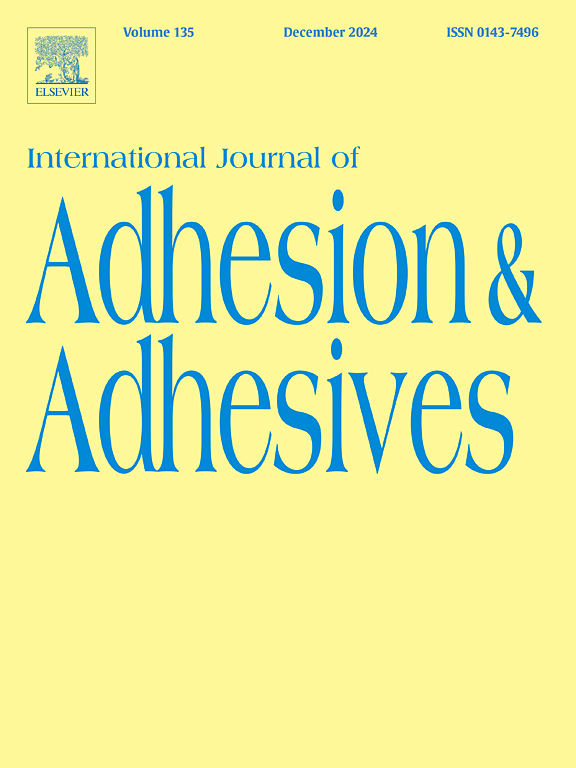包含生物启发形态不规则性的粘合异种材料接头的机械和破坏行为
IF 3.2
3区 材料科学
Q2 ENGINEERING, CHEMICAL
International Journal of Adhesion and Adhesives
Pub Date : 2024-10-22
DOI:10.1016/j.ijadhadh.2024.103865
引用次数: 0
摘要
研究了 316L 不锈钢和聚对苯二甲酸乙二酯(PETG)塑料之间的粘合异种材料接头,其中采用了受天然缝合线启发的不规则界面形态。根据伪随机方法和缝合线相互咬合指数,接头界面呈现出各种齿状、不重复的之字形图案。通过实验和有限元模拟研究了其不规则性对粘合对接接头的机械特性和失效特性的影响。界面和 PETG 分别采用了内聚区模型、Drucker-Prager 塑性模型和韧性破坏准则。不同齿形接头的预测载荷-位移曲线得到了很好的验证。不规则度越高,分别为 20%、40% 和 60%,接头强度分别降低了 1.47%、5.39% 和 11.95%,而失效总能量则相应增加了 110.74%、129.33% 和 161.23%。更不均匀的形态导致局部损伤更早开始,但由于阻碍了接头的突然分离,损伤演化范围扩大了。较小的齿角能提供较高的接合强度,而过大的齿角会导致应力过度集中并导致齿断裂,从而显著降低接合强度。齿角为 45°时,由于在剪切应力状态下适当结合了互锁和大粘合力,因此接头性能优越。最后,还为设计具有形态不规则性的最佳异种接头提供了重要启示。本文章由计算机程序翻译,如有差异,请以英文原文为准。
Mechanical and failure behaviors of adhesively bonded dissimilar materials joints incorporating bio-inspired morphological irregularities
Adhesive dissimilar material joints between stainless steel grade 316L and polyethylene terephthalate glycol (PETG) plastic were examined, in which irregular interface morphologies inspired by natural sutures were incorporated. The joint interfaces exhibited various teeth-like, non-repetitive zigzag patterns based on a pseudo-randomization method and sutural interdigitation index. Effects of their irregularities on mechanical and failure characteristics of adhesive butt joints were studied by means of experiments and FE simulations. The cohesive zone model, Drucker-Prager plasticity model and ductile failure criterion were applied for the interface and PETG, respectively. Predicted load-displacement curves of joints with different teeth profiles were well validated. The degree of irregularity became higher to 20 %, 40 %, and 60 %, the joint strengths decreased by 1.47 %, 5.39 %, and 11.95 %, while the total energies to failure increased by 110.74 %, 129.33 %, and 161.23 %, accordingly. More inhomogeneous morphologies led to earlier local damage initiation, but enhanced damage evolution range by impeding abrupt joint separation. Smaller teeth angles provided higher joint strength, whereas significant declines of bonding strength were observed by too acute teeth angle due to excessive stress localization and resulting teeth breakage. The teeth angle of 45° enabled the superior joint performance owing to a proper combination of interlocking and large adhesive force under shear stress state. Finally, a key insight for designing an optimal dissimilar joint with morphological irregularities was provided.
求助全文
通过发布文献求助,成功后即可免费获取论文全文。
去求助
来源期刊

International Journal of Adhesion and Adhesives
工程技术-材料科学:综合
CiteScore
6.90
自引率
8.80%
发文量
200
审稿时长
8.3 months
期刊介绍:
The International Journal of Adhesion and Adhesives draws together the many aspects of the science and technology of adhesive materials, from fundamental research and development work to industrial applications. Subject areas covered include: interfacial interactions, surface chemistry, methods of testing, accumulation of test data on physical and mechanical properties, environmental effects, new adhesive materials, sealants, design of bonded joints, and manufacturing technology.
 求助内容:
求助内容: 应助结果提醒方式:
应助结果提醒方式:


